Sub-saharan Africa accounts for the least cryptocurrency transaction volume of any region we study, with $100.6 billion in on-chain volume received between July 2021 and June 2022, which represents 2% of global activity, and 16% growth over the year prior.
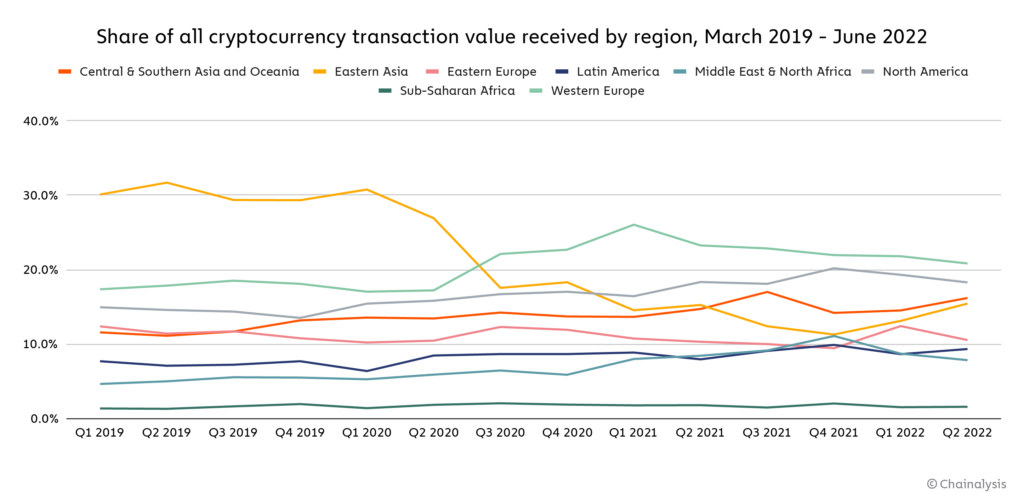
However, numbers can be deceiving, as deeper analysis reveals that Africa contains some of the most well-developed cryptocurrency markets of any region, with deep penetration and integration of cryptocurrency into everyday financial activity for many users. We see this primarily in Nigeria and Kenya, which rank 11th and 19th on our Global Crypto Adoption Index respectively. Both countries see strong adoption when weighted for purchasing power and population, especially on P2P exchanges, which expert interviews confirm are crucial to the region’s crypto economy. South Africa, which leads the region in raw transaction volume, also ranks high on our index at 30th.
The 2022 Geography of Cryptocurrency Report
Everything you need to know about crypto trends around the world!

Small retail transactions power crypto markets in Sub-Saharan Africa
Sub-Saharan Africa’s retail market and outsized usage of P2P platforms make it unique compared to other regions. Retail-sized transfers below $10,000 USD make up 6.4% of its transaction volume, more than any other region. The role of retail becomes even more apparent when we look at the number of individual transfers. Retail transfers make up 95% of all transfers, and if we drill down to just small retail transfers under $1,000, the share becomes 80%, more than any other region.
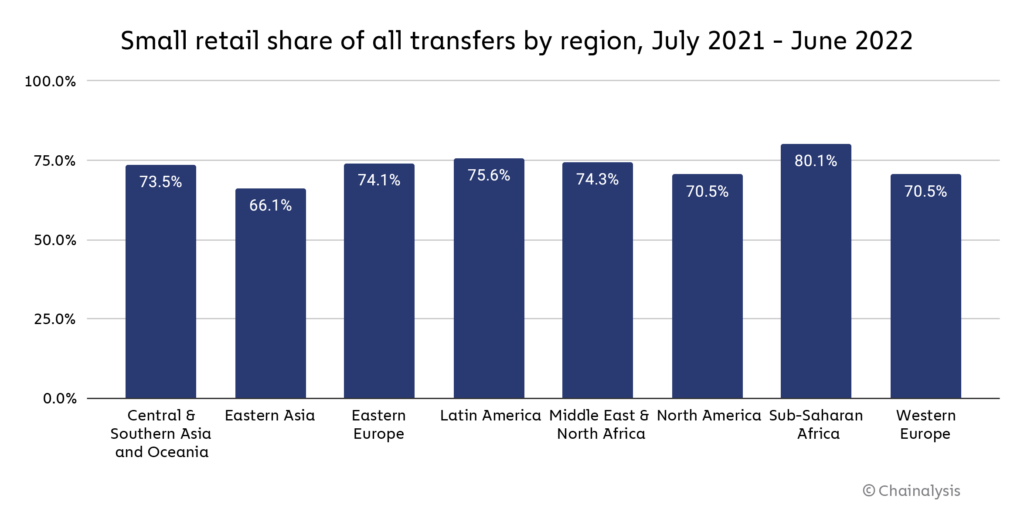
Our interviews suggest that this reflects the trend of many young people in Sub-Saharan Africa turning to cryptocurrency as a way to preserve and build wealth in spite of low economic opportunity, as opposed to other countries where we see many using cryptocurrency as a way to multiply their existing wealth. Adedeji Owonibi, founder of Nigeria-based blockchain consultancy and product studio Convexity, told us more about this dynamic. “We see a lot of daily traders who are trading to make ends meet,” he said. “We don’t have big, institutional-level traders in Sub-Saharan Africa. The people driving the market here are retail. Nigeria has a ton of highly educated young graduates with high unemployment rates, no jobs available — crypto to them is a rescue. It’s a way to feed their family and solve their daily financial needs.” According to Adedeji, the volatility of the Nigerian naira also drives the need for cryptocurrency in the country, as users believe they can better preserve their savings with stablecoins like Tether.
Crypto usage driven by everyday necessity, as opposed to speculation by the already-well off, could explain an interesting phenomenon we saw in Sub-Saharan Africa this year: The number of small retail transfers actually grew starting at the onset of the bear market in May, while the number of transfers of other sizes fell.
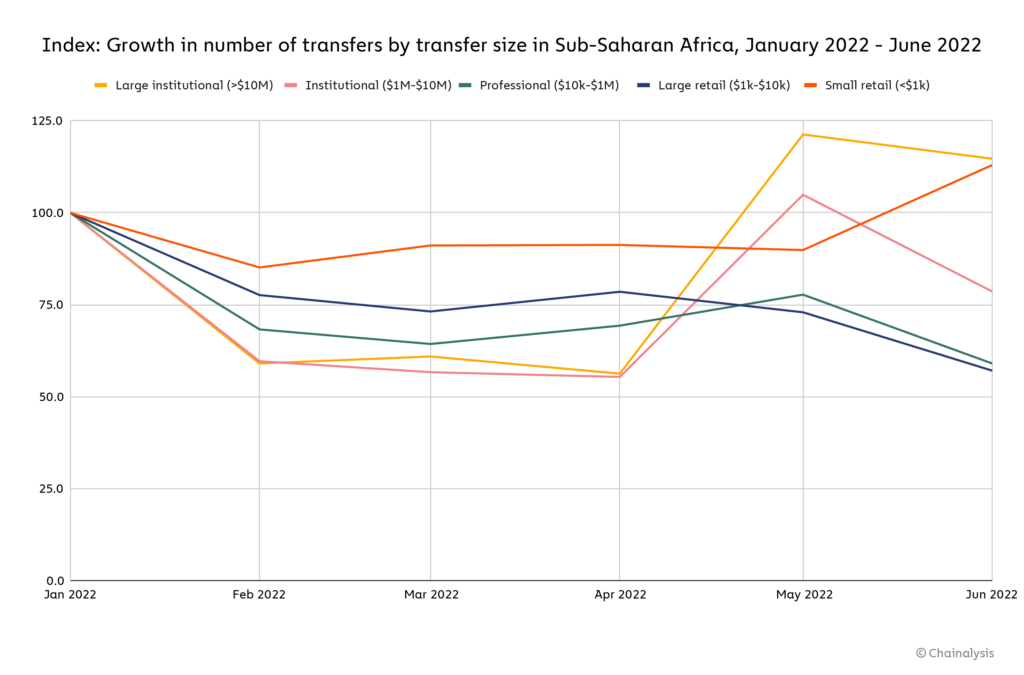
If many of the people carrying out small retail transactions are trading cryptocurrency out of economic necessity — especially in countries where the values of local fiat currencies are dropping, as we’ve seen in Nigeria and Kenya, for example — then those people may be more willing to continue trading despite price drops. And of course, users buying stablecoins like Tether would be unaffected by drops in prices for Bitcoin, Ethereum, and the like.
P2P exchanges are a crucial part of the ecosystem
We also see heavy adoption of P2P exchanges. P2P exchanges account for 6% of all cryptocurrency transaction volume in Africa, more than double the share of the next-closest region, Central & Southern Asia and Oceania.
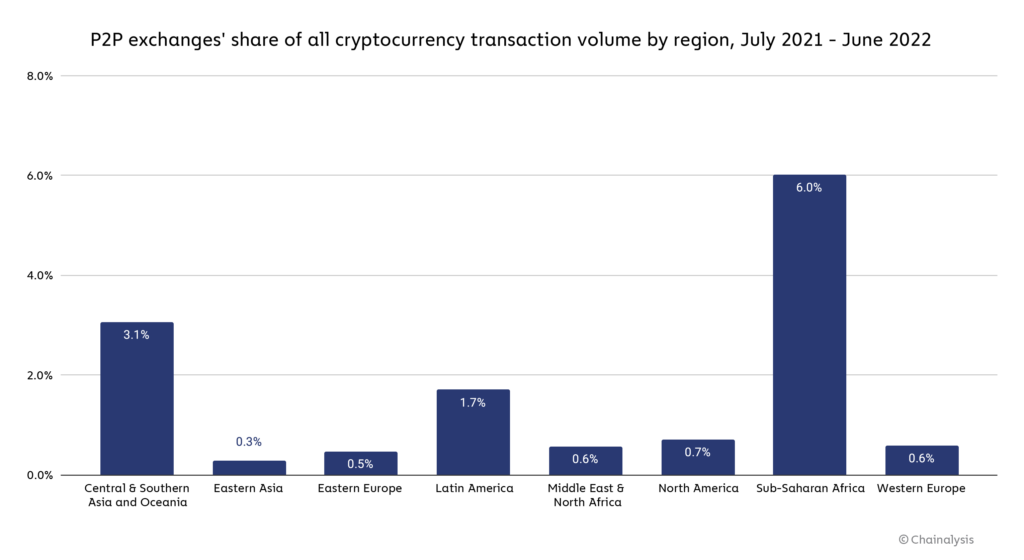
We spoke with Ray Youssef, CEO of popular P2P platforms Paxful, to understand why. According to Ray, Sub-Saharan Africa is a major growth driver for Paxful, with 55% year-over-year user growth of remittance users in Nigeria — already Paxful’s biggest market — and nearly a whopping 140% in Kenya. He explained to us how P2P platforms like Paxful initially took hold in Africa as some of the first services residents could use to buy cryptocurrency. “We had to get Bitcoin into Africa, which was difficult because it’s so hard to get money out of Africa. We needed a clever hack to make that happen,” said Ray. That hack ended up being gift cards. “We connected Nigerians with Chinese gamers who wanted to buy app store gift cards, and a huge trade market was born. That got Bitcoin into Nigeria, and then the rest of Western Africa.” Strategies like the one Ray described allowed P2P platforms to drive early Bitcoin activity in Sub-Saharan Africa, and the services have proved to have staying power in the region.
Regulations limiting crypto activity can also drive P2P exchange usage. The Nigerian government prohibited banks from transacting with cryptocurrency businesses in 2021, and while this action doesn’t appear to have dampened overall cryptocurrency transaction volumes, it has affected usage patterns. We spoke to an analyst at Nigeria’s Financial Intelligence Unit to learn more. “Nigeria restricted the usage of the Naira for buying crypto in 2021 due to concerns around scams and tax evasion, and because of that, many people began trading peer-to-peer,” the analyst told us.
That activity goes beyond conventional P2P platforms like Paxful though. Many in Nigeria are also trading cryptocurrency directly with one another, sourcing deals through group chats on apps like WhatsApp and Telegram. Our geographic data doesn’t reflect this activity since it takes place through private wallet interactions, but our interviewees described it as a big part of Nigeria’s cryptocurrency ecosystem. Adedeji Owonibi told us more. “These groups have thousands of people from all over the world — Nigeria, China, Dubai and more — trading crypto with each other,” he said. “The groups are where the volume is happening.”
Commerce and remittances also power crypto adoption in Sub-Saharan Africa
In addition to trading and saving, Ray and Adedeji told us about two other use cases powering crypto adoption in Sub-Saharan Africa: remittances and commerce.
Remittances from overseas have long been important for Sub-Saharan African economies, and inflows to the region grew 14.1% to $49 billion in 2021 following a decline the previous year. However, these payments can be expensive and difficult to make. Ray Youssef explained more. “Making an international payment in a country like Nigeria, Cameroon, or Senegal is almost impossible. There’s no pan-African payment solution. There are thousands of payment networks in Africa, and only a fraction of them talk to each other,” he told us. Ray described one Kenyan expat he knew who had to pay €200 for every €1,000 she tried to send home from Europe. Ray was able to help that woman use Paxful to buy Bitcoin, sell it to another user for Kenyan shillings via M-PESA, a Kenyan payments network, which the woman could then transfer directly to her family. “She actually ended up making a 4% profit rather than paying 20% in fees because the user she transacted with was willing to pay a premium for the Bitcoin,” said Ray.
Commercial transactions are another use case. Adedeji Owonibi told us that many businesses relying on international suppliers have turned to crypto for payments, as sending funds abroad is difficult due to Nigeria’s tight capital controls. “Companies need to buy materials from the United States, but there’s no way to get the money there — they’re left with no option but to use USDT.” He cited China as another popular trading partner for these crypto-based commercial transactions.
Future growth in Sub-Saharan Africa
What countries will power the next round of growth for Sub-Saharan Africa? Ray pointed to Ghana as one place that he expects to achieve similar adoption levels to Nigeria and Kenya, based on current growth trends and the needs of the local population. “Lots of Nigerians consider Ghana their summer home and spend lots of time there, and they’re educating the locals on Bitcoin,” said Ray. He told us that over the last year, Paxful’s total trade volume in Ghana has grown by nearly 100% in the last year and over 400% in the last two years. That aligns with data we’ve found showing that Ghana – along with several other Sub-Saharan African countries – has seen substantial.
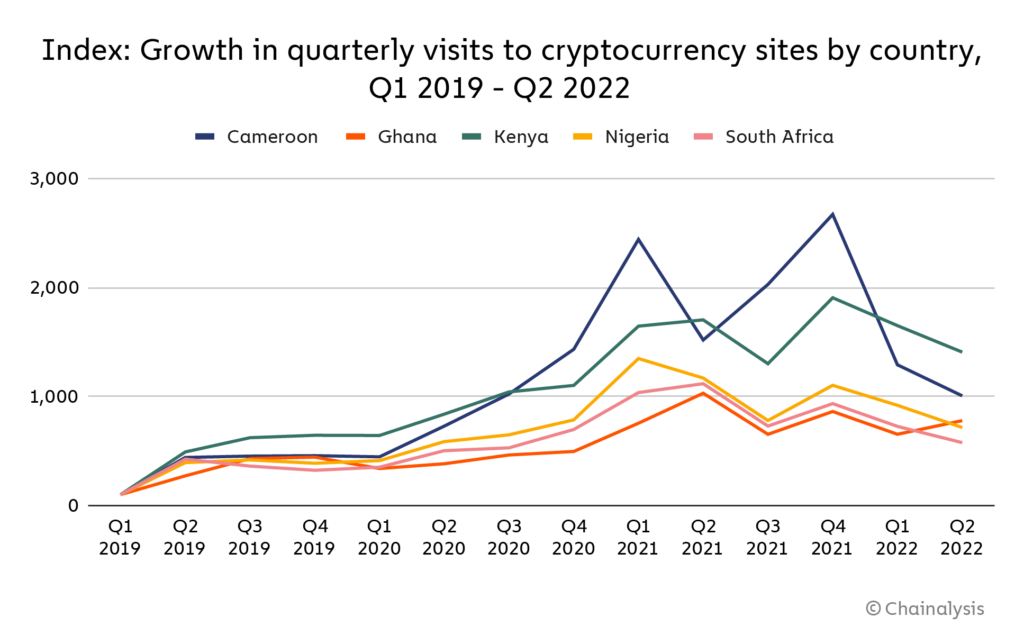
Overall, we expect cryptocurrency usage in Sub-Saharan Africa to continue growing as long as residents face issues crypto has proven it can solve for them, such as preserving savings through economic volatility and enabling cross-border transactions in places with strict capital controls.
This blog is an excerpt from our 2022 Geography of Cryptocurrency Report. Sign up to download your copy today!
